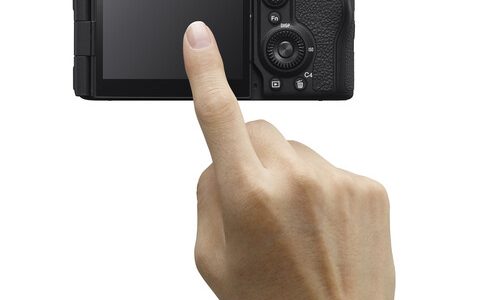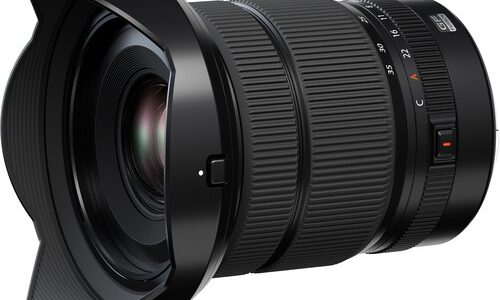

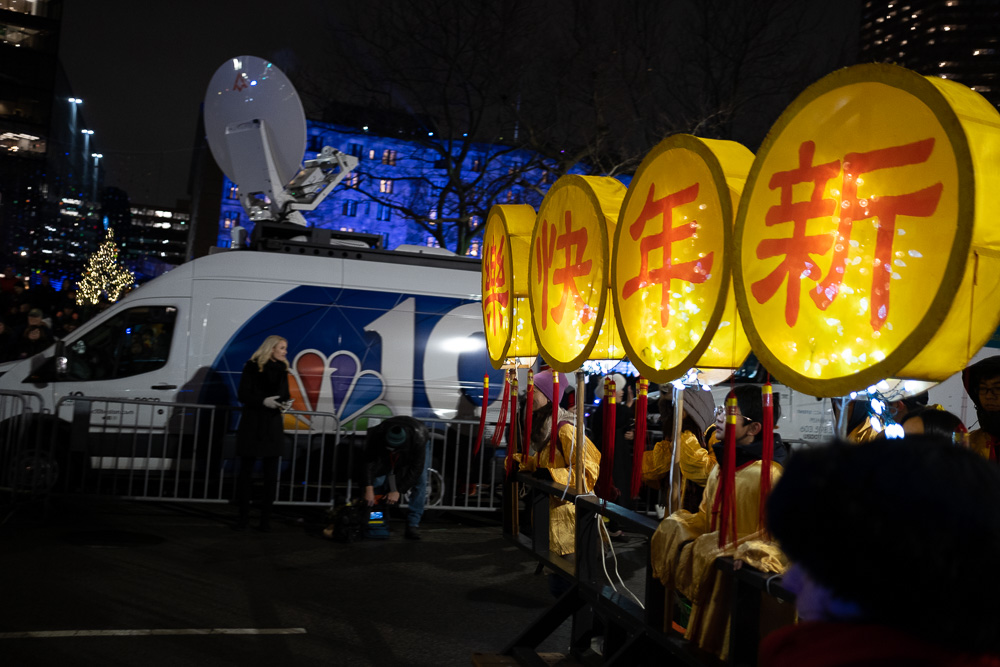

The X-Pro 3 is the most “Fujifilm” in philosophy of any camera I have ever used, and it is a camera that makes you want to go out and shoot with it. It’s not perfect, nor will it probably serve as anyone’s only camera – but it is a wonderful addition to a collection of cameras because it really focuses your eye on the photograph in front of you. It’s a modern digital camera with excellent image quality, but it tries its best to make you forget that fact and forget that it contains a computer at all. If the GFX 100 is a “head” camera where you put up with a somewhat bulky, unergonomic camera in order to get the best image quality on the market, the X-Pro 3 is a “heart” camera where the experience of using it is a major part of its value.
The X-Pro 3 is a unique camera – and Fujifilm is proud of its idiosyncrasies. It’s about the most appealing and just plain fun camera I have photographed with in years, largely because it changes how you think about photography. It is certainly not for everyone, nor is it an only camera for most people, but it will get your eye focused on the image and looking through the viewfinder in an interesting way.
In most ways, it’s a Fujifilm X-T3 (probably the finest APS-C mirrorless camera on the market today, especially when you take the lens lineup into account) in an X-Pro series body. The sensor is a Fujifilm modification of Sony’s newest 26.1 MP APS-C sensor, with Fujifilm’s X-Trans color filtration. It is probably the most capable non full-frame sensor on the market today, slightly exceeding the resolution and dynamic range of the best previous Sony 24 MP sensors found in a variety of cameras, and giving up some resolution to the latest 32 MP Canon sensor, but comfortably exceeding it in dynamic range. Fujifilm color is, as always, excellent.
The unique X-Pro body is styled like a Leica with a hybrid viewfinder, instead of a small DSLR with a purely electronic finder. The hybrid viewfinder is a longtime X-Pro series feature – the viewfinder actually has an optical mode where it displays framelines superimposed on a direct view of the scene, as well as a conventional electronic mode.
There is no optical rangefinder – focus in optical mode is achieved either through autofocus or by means of an electronic display superimposed on the lower left corner of the viewfinder, which offers a variety of focus aids. The hybrid viewfinder has become more electronic-focused in the X-Pro 3 than in previous iterations of the series. The optical finder used to have dual magnifications that made it useful with lenses from about 16 or 18 mm (the entire finder window was the frame at the lower magnification) out to 90mm or so (still a reasonable frameline size at the higher magnification).
In order to fit a better electronic viewfinder, Fujifilm dropped the dual magnification feature, choosing a compromise magnification. In the X-Pro 3, a 23mm lens has approximately the same field of view as the optical finder, and it is quite usable in optical mode using the entire finder as the frame. Depending on your tolerance for small framelines, the optical finder is usable for lenses as long as 50-60mm. Another quirk of the optical finder is that large lenses intrude into the finder’s field of view – most of the zooms other than the little 18-55 f2.8-4 take up so much of the field of view that they really need to be used in electronic mode. The real purpose of the optical finder mode is to use with Fujifilm’s excellent trio of tiny f2 “Fujicron” primes – 23mm, 35mm and 50mm (the 27mm f2.8 is probably another good choice).
The positive side of the viewfinder change is that the electronic finder has improved radically over the X-Pro 2 and previous versions. Prior to the X-Pro 3, the electronic side of the hybrid finder was always compromised by comparison to any contemporary purely electronic finder – it was an LCD with relatively low resolution and contrast. By simplifying the optical component, Fujifilm found room for an OLED that gives up little if anything to modern purely electronic finders. Other than with the little f2 Fujicron primes, this is primarily a conventional mirrorless camera with an excellent electronic viewfinder.
While the unusual feature of the X-Pro series has always been the hybrid viewfinder, Fujifilm has gone even more exotic with the X-Pro 3. For all intents and purposes, it lacks a rear image display! It has a small, low-resolution information display on the camera back, which mimics a film box end displaying the current ISO and film simulation mode (if you don’t like the skeuomorphism, you can set a menu option that converts it to a very clear version of a standard camera top info LCD). Unfold the back and an excellent, high-resolution rear image display similar to those on most modern cameras is hidden INSIDE.

The only way to see the rear display is to fold it out so it hangs awkwardly below the camera. The message is clear – “eyes on the viewfinder – no chimping!”. If you need to see how a particular image turned out, the rear display is easy enough to get at, and it is certainly accessible for menu-diving – but it is not meant for daily use. One of the great advantages of the X-Pro series is that they have always been about as close to a menu-free digital camera as you can get. Most important settings are reached through a large number of beautifully marked controls on the camera body, including a shutter speed knob that would do any manual Nikon or Leica from the 1950s through the 1980s proud. For initial setup and occasional reconfiguration, the screen is accessible enough.
The ISO setting is on an inner dial – lift up the shutter knob and turn to rate your “film” at any ISO you want, and, since this is a modern Sony sensor, you can rate it at outrageous speeds up to ISO 12,800, with extended modes reaching ISO 51,200. Disappointingly, the minimum ISO is 160 – the X-Pro series really cries out for a very low minimum ISO, given that Nikon gets ISO 64 (with real image quality benefits) out of similar sensor technology. The X-Pro 3 really cries out for a setting on that dial that loads it up with Velvia 50, for the sharpest, most noise-free images the camera can offer. I would be happy to give up a couple of stops on the top end for true low ISOs. It could also be a differentiating feature between the X-Pro and X-T series – the X-T, which is more action-oriented, could feature higher ISOs, while the beautifully contemplative X-Pro gets the low speeds. I would far rather see an ISO range of 40-3200 than 160-12800 on a camera like this.
The X-Pro 3 is the sturdiest camera Fujifilm has released to date – they claim excellent weather sealing (recent Fujifilm cameras have been very well sealed), and the top and bottom are built of titanium, a wonderfully light and strong metal that is nearly impossible to machine, causing camera manufacturers to avoid it. There have been a few titanium cameras over the years, including the Olympus OM-4Ti that was beloved of Everest expeditions in the 1980s and 1990s and the Nikon F3T favored by war correspondents around the same time. The base model X-Pro 3 is painted black, while a $200 cost increment buys a high-end anodized finish in black or silver (Fujifilm calls it Dura-black and Dura-silver). My review model was the standard black paint, but, after seeing the finishes at PhotoPlus Expo, I would choose the Dura-silver to show the natural beauty of the titanium.

The one real design weakness, shared among all current APS-C Fujifilm bodies, is the venerable NP-W 126S battery. The tiny battery was first introduced on the original X-Pro 1, and it was barely adequate for a camera with only prime lenses and no video mode to speak of. It is woefully inadequate with today’s image-stabilized zooms and 4K video. Fortunately, spares are very light – unfortunately, they’re expensive. Fujifilm has also declined to include a battery charger in the X-Pro 3 box – the only charging solution they supply is a USB-C cable to charge the battery in-camera.
Most X-Pro 3 buyers will already own a Fujifilm camera (or several), so they are likely to have one or more battery chargers around. If you are interested in an X-Pro 3 and don’t own a charger, remember to pick one up when you buy the camera. Fujifilm’s own BC-W126S is a little over $40, but there are other options that may well serve your needs better, since the BC-W126S is quite bulky for the size of the battery, and not especially fast. Nitecore’s FX1 is a compact dual-slot USB-powered smart charger that is significantly smaller and lighter than the BC-W126S for around $30. Cheaper USB chargers are not recommended, because they are likely to not be true smart chargers. B&H’s Watson brand sells a dual-slot desktop quick charger with an excellent information display for $80, which is especially appealing if you own more than one brand’s cameras – a simple change of $2 adapter plate allows the Watson to charge a different battery (and the two slots can have different plates). The ultimate in camera battery chargers come from Dolgin Engineering – they cost a few hundred dollars, but they take very good care of your batteries – they’re as good as what Hollywood uses (in many cases, they are what Hollywood uses)!

Fujifilm generally relies on image stabilization in the lens – most of the zooms and only a couple of the primes are stabilized. The only Fujifilm cameras with in-body stabilization are the discontinued X-H1 and the medium-format GFX 100, although there is a persistent rumor of an upcoming stabilized APS-C body. Their lens stabilization technology works quite well, offering at least 3 stops of real-world stabilization (nobody except Olympus comes close to the 5 stop claims in brochures, or to shooting at ¼ second and slower)! Sharp images around 1/10 – 1/15 second are possible at modest focal lengths with the 16-80mm f4 lens. The only real disadvantage to the way Fujifilm chooses to stabilize is the lack of any stabilization at all with many lenses.
There has been quite a bit of controversy online about whether the reversed screen is a good design decision or a bad one. If you don’t like it, Fujifilm also offers the X-T3 – essentially the same camera, minus the optical viewfinder and a few other retro touches, but with a couple of extra video modes and a conventionally positioned rear screen. Personally, I find that the X-Pro 3’s rear screen position concentrates my attention where it belongs – on the image I am composing in the viewfinder. The three reasons to buy an X-Pro 3 over the similar X-T3 are the screen, the durability of the titanium and the optical viewfinder. For my own shooting style, I would choose the X-Pro 3 over the X-T3, even though I don’t find the optical viewfinder especially useful – the combination of the durability and the distraction-free experience are worth the price premium. This is, of course, a very personal decision – both are wonderful cameras.
I would choose an X-T3 (or the less expensive X-T30) for the serious beginning photographer, where image review adds to confidence that the image is what you envisioned. While expensive compared to entry-level DSLRs, there is no better camera to learn on than a Fujifilm – their control philosophy allows the use to make immediate connections between settings and image.
For the videographer, the X-T3 is the obvious choice (although there are rumors of an X-T4 coming in the next several months with in-body image stabilization and perhaps even a 6K video mode). A few years ago, any Fujifilm camera would have been an unusual, perhaps even inexplicable choice for video – but the X-T2 added excellent video modes and high-quality 4K, while the X-T3 adds 4Kp60 video that is competitive with anything short of a Panasonic S1h. The X-Pro 3 offers most of the X-T3 video modes, but not the highest-quality of them, and the inconvenient rear screen is a major limitation for video, where the rear screen is often the preferred finder.
Who, then, is the X-Pro 3 for? It is for the artist who wishes to concentrate on their craft with as few digital distractions as possible. It is easy to forget that it is not a film camera while using it, but it offers much higher image quality than any 35mm film camera could dream of, while being a great deal more compact than a medium format film camera. For street, reportage and portrait photography, it feels like a classic Leica, a perfect match for the trio of tiny, beautiful f2 “Fujicron” lenses with well-chosen 23,35 and 50mm focal lengths – they match the classic 35,50, 75mm trio on film. There is also an 18mm prime that offers 28mm equivalent, but it is too wide for the optical viewfinder, and the only 60mm (90mm) primes are an older macro lens and a much larger 56mm f1.2. Fujifilm would do well to release a 60-65mm Fujicron to round out the set.
It is also well suited to other genres of artistic photography – its compact, sturdy body is an excellent landscape companion that will survive the rigors of weeks in the back-country. I took an X-T2 backpacking on 450 miles of the Pacific Crest Trail a couple of years ago, and it survived and returned with beautiful images. If anything, the durability of the X-Pro 3 is improved over what I had in 2017, with the titanium body and some improvements to weather sealing.
The challenge for the X-Pro 3 is that it is the most expensive non-Leica APS-C camera currently manufactured. No other manufacturer could reasonably charge $1800-$2000 for an APS-C camera, because nobody else has the lenses to support a camera at that price point. Many 24 mp full-frame cameras are significantly cheaper than the APS-C X-Pro 3, and even high-resolution full-frame models sometimes fall to similar prices when rebates are good. Fujifilm’s lens lineup makes the X-Pro 3 a far more reasonable proposition than it would otherwise be. Fujifilm offers APS-C dedicated lenses from ultra-wide to significant telephoto, with full ranges of both primes and zooms. There are as many choices available as for the other two full-line mirrorless options, Sony full-frame or Micro 4/3, with nearly uniformly high quality. The Fujifilm line far exceeds either Nikon’s or Canon’s APS-C lens options (not to mention Sony’s generally poor APS-C options), although it does not offer some of the exotics that Nikon and Canon offer in their full-frame DSLR lines. Of course, Nikon, Canon and Sony APS-C cameras have access to their manufacturer’s excellent full-frame lineups, although at a cost in both bulk and price.
The first important competitor to the X-Pro 3 is Fujifilm themselves – they make a number of bodies that use the same 26.1 mp APS-C sensor. The same basic sensor and feature set, with access to the same lenses, is available for half the price from Fujifilm themselves in the X-T30, without the durable build or the unique shooting experience. The same sensor and lenses, with nearly comparable build quality and more video features are available for a slightly lower price than the X-Pro 3 in the X-T3. The extra cost for the X-Pro 3 buys a very particular shooting experience and an even more durable body.
Other manufacturers’ APS-C cameras are cheaper still, with basically similar feature sets – but the lens disadvantage is significant. A Sony a6100, for $700 with a kit zoom lens, offers an older version of a similar sensor and most of the photographic features of an X-Pro 3 – but the 16-50mm lens included with the kit is one of the worst lenses DxOMark has ever tested (and there are few gems among Sony’s APS-C lineup), and the shooting experience is very different. Instead of the beautifully crafted Fujifilm with every control falling perfectly to hand, the Sony is both somewhat fragile (no weather sealing at all) and a notably difficult camera to control, with one dial doing triple duty for shutter speed, aperture and exposure compensation (all separate and well-placed controls on the X-Pro 3). The market is not the same for two cameras with a ~3:1 price ratio, but the basic digital features are similar enough that comparisons are inevitable. Fujifilm’s argument is that a beautifully crafted tool with access to superb lenses is worth the large premium.
The next four images are brick wall shots – all actual pixels, all on the Mighty Robus (my 55 lb capacity tripod) and set off with the self-timer. The camera didn’t move, and Memorial Hall didn’t, either.
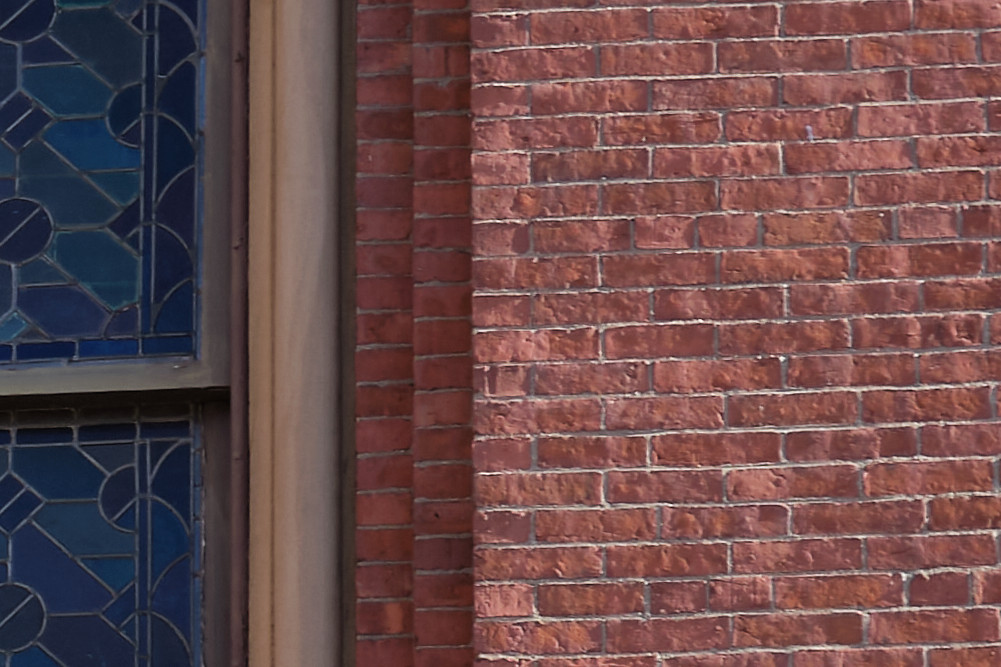
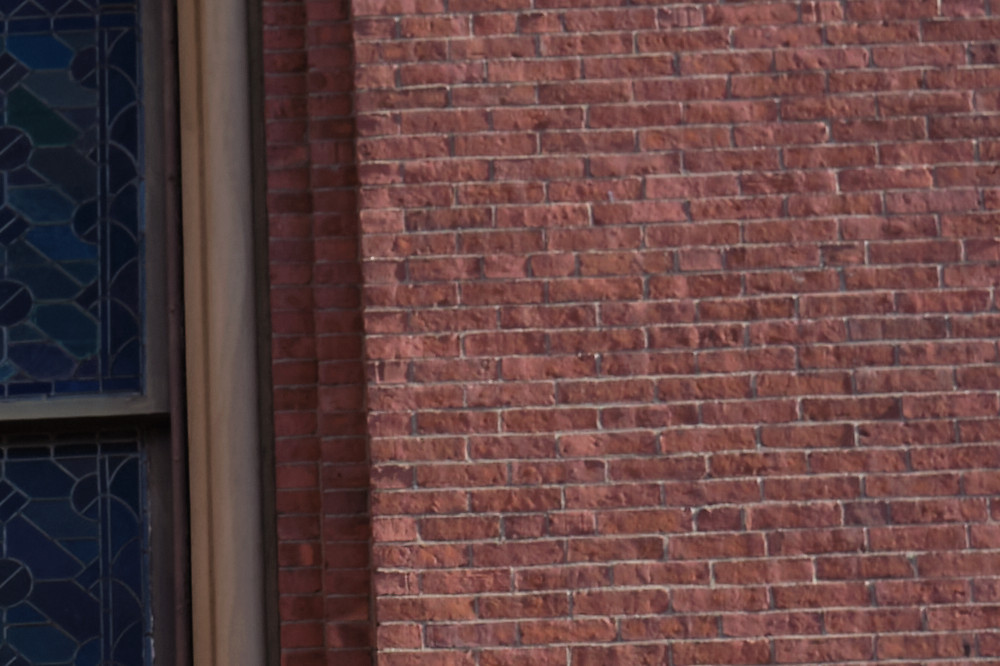
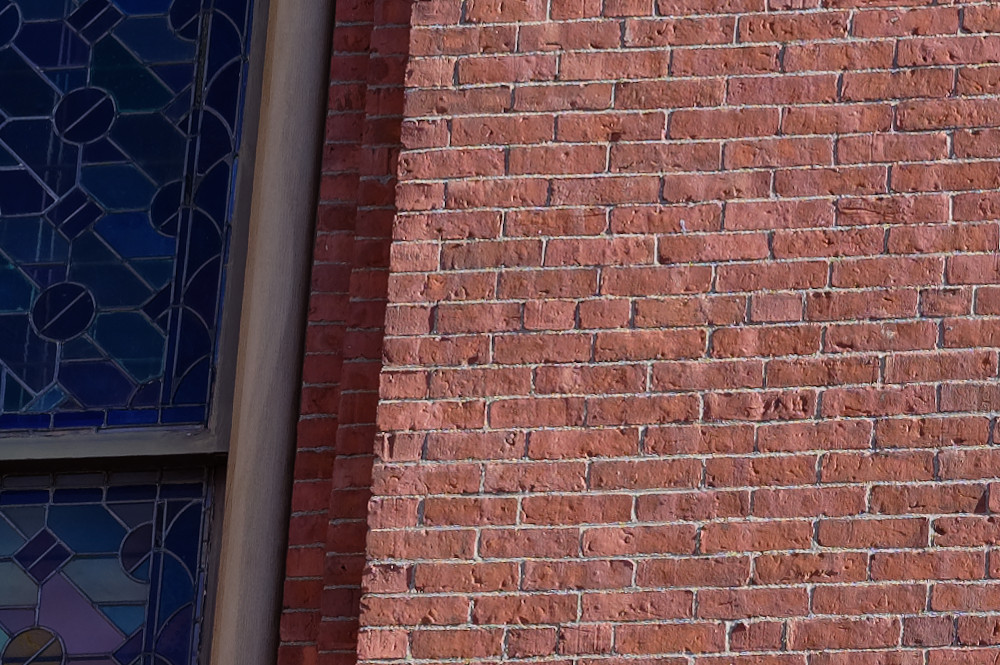

Against 24 mp full-frame, the price comparison is much closer – and this is where Fujifilm is aiming. The Sony A7III and Nikon Z6 are both very capable cameras, and they each come out within a few hundred dollars of the X-Pro 3, sometimes cheaper, depending on lens choices. All three can be appealing cameras to shoot, with well thought out controls, depending on what you like. Personally, I prefer both Fujifilm and Nikon controls to Sony, but I have also used far fewer Sony cameras in my life, and (unlike the a6000, which has very skimpy controls), at least part of my feelings may simply be unfamiliarity. The A7 III has a full set of dials, buttons and joystick – they just aren’t placed where I’d expect them (with some more experience with a Sony, I’d probably find them by feel). Fujifilm’s controls are classic, reminding the photographer of a Leica, while Nikon’s are modern – the Nikon F5 redefined the basic interface of a camera in the 1990s, and the Z6 is definitely in the F5 family tree.
Does it matter that the Fujifilm is APS-C in this comparison? I would argue that it doesn’t really. I didn’t realize quite how sharp the 50mm Nikkor is until I looked at comparisons that shouldn’t have been fair and the 50mm Nikkor blew away higher-resolution cameras with ordinary lenses. The 23mm Fujicron and the 16-80 zoom can’t hold a candle to the much larger, much more expensive Nikon lens – but they’re not really supposed to – both are sharp examples of the kind of lenses they are. With a comparable lens like the Fujifilm 56mm f1.2, the Fujifilm would have probably held up very well.
Fujifilm doesn’t offer the X-Pro 3 with a kit lens – options include the Fujicrons (which seem made for this body), and a number of excellent zooms and larger primes. The Z6 comes with the excellent 24-70mm f4 Nikkor Z at a $400 discount (it’s not the 50, but it’s one of the sharpest zooms I’ve ever used) – the only reason to buy a Z6 without the lens is if you already own the lens… Sony’s default kit for the A7 III includes the very low-end 28-70mm f3.5-5.6 at a $200 discount. It adds only a couple of hundred dollars to the price of the body, but it’s not a great lens. The much more expensive 24-105mm f4 G is a much better lens, but there is no discount on that combination as of January 25, 2020. Discounts change all the time, and X-Pro 3 kits and Sony bodies with better lenses are both real possibilities.
The final comparison for the X-Pro 3 (and it is a difficult one for Fujifilm) is that it’s not all that much cheaper than some of the high-resolution full-frame bodies when the latter go on sale. While the X-Pro 3 can hold up reasonably well to a Nikon Z6 in terms of image quality, it is outclassed by a Z7. The same holds in comparison to a Sony A7 III and an A7r III (the A7r IV is substantially more expensive). Some of the same contemplative photographers who will especially enjoy the X-Pro 3 are also likely to print big – bringing them into the customer base of the high-resolution bodies. If you don’t print larger than 16×24”, don’t worry about the high resolution bodies unless you want the Z7’s additional dynamic range due to its low minimum ISO. If you do print larger than 16×24”, the resolution matters and the Z7 and its 24-70mm f4 kit lens are only about 4 ounces (120 grams) heavier than the X-Pro 3 with the 16-80mm f4 (Fujicrons or the little 18-55 f2.8-4 zoom increase the weight differential) once you add an extra battery to the Fujifilm setup. The Z7 kit can be as little as a few hundred dollars more expensive on sale. The Z7 offers a different, less classic experience, but it, too is an excellent camera to shoot.
If you enjoy the particular, contemplative shooting style the X-Pro 3 offers, and you don’t need ultra-high resolution, it is one of the most fun cameras to shoot in a long time. It encourages the photographer to concentrate on art, rather than menus and gadgets. Its wonderful lens line matches the body very well. It is an expensive camera, but it is also a special one. Highly Recommended for the street or portrait photographer, for Fujifilm enthusiasts who want the ultimate expression of the brand’s idiosyncratic philosophy, and for landscape photographers who don’t print especially large.
Dan Wells
February 2020

Lorem ipsum dolor sit amet, consectetur adipiscing elit, sed do eiusmod tempor incididunt ut labore et dolore magna aliqua. Ut enim ad minim veniam, quis nostrud exercitation ullamco laboris nisi ut aliquip ex ea commodo consequat. Duis aute irure dolor in reprehenderit in voluptate velit esse cillum dolore eu fugiat nulla pariatur. Excepteur sint occaecat cupidatat non proident, sunt in culpa qui officia deserunt mollit anim id est laborum.
Lorem ipsum dolor sit amet, consectetur adipiscing elit, sed do eiusmod tempor incididunt ut labore et dolore magna aliqua. Ut enim ad minim veniam, quis nostrud exercitation ullamco laboris nisi ut aliquip ex ea commodo consequat. Duis aute irure dolor in reprehenderit in voluptate velit esse cillum dolore eu fugiat nulla pariatur. Excepteur sint occaecat cupidatat non proident, sunt in culpa qui officia deserunt mollit anim id est laborum.

Lorem ipsum dolor sit amet, consectetur adipiscing elit, sed do eiusmod tempor incididunt ut labore et dolore magna aliqua. Ut enim ad minim veniam, quis nostrud exercitation ullamco laboris nisi ut aliquip ex ea commodo consequat. Duis aute irure dolor in reprehenderit in voluptate velit esse cillum dolore eu fugiat nulla pariatur. Excepteur sint occaecat cupidatat non proident, sunt in culpa qui officia deserunt mollit anim id est laborum.
Lorem ipsum dolor sit amet, consectetur adipiscing elit, sed do eiusmod tempor incididunt ut labore et dolore magna aliqua. Ut enim ad minim veniam, quis nostrud exercitation ullamco laboris nisi ut aliquip ex ea commodo consequat. Duis aute irure dolor in reprehenderit in voluptate velit esse cillum dolore eu fugiat nulla pariatur. Excepteur sint occaecat cupidatat non proident, sunt in culpa qui officia deserunt mollit anim id est laborum.

Lorem ipsum dolor sit amet, consectetur adipiscing elit, sed do eiusmod tempor incididunt ut labore et dolore magna aliqua. Ut enim ad minim veniam, quis nostrud exercitation ullamco laboris nisi ut aliquip ex ea commodo consequat. Duis aute irure dolor in reprehenderit in voluptate velit esse cillum dolore eu fugiat nulla pariatur. Excepteur sint occaecat cupidatat non proident, sunt in culpa qui officia deserunt mollit anim id est laborum.
Lorem ipsum dolor sit amet, consectetur adipiscing elit, sed do eiusmod tempor incididunt ut labore et dolore magna aliqua. Ut enim ad minim veniam, quis nostrud exercitation ullamco laboris nisi ut aliquip ex ea commodo consequat. Duis aute irure dolor in reprehenderit in voluptate velit esse cillum dolore eu fugiat nulla pariatur. Excepteur sint occaecat cupidatat non proident, sunt in culpa qui officia deserunt mollit anim id est laborum.
Lorem ipsum dolor sit amet, consectetur adipiscing elit, sed do eiusmod tempor incididunt ut labore et dolore magna aliqua. Ut enim ad minim veniam, quis nostrud exercitation ullamco laboris nisi ut aliquip ex ea commodo consequat. Duis aute irure dolor in reprehenderit in voluptate velit esse cillum dolore eu fugiat nulla pariatur. Excepteur sint occaecat cupidatat non proident, sunt in culpa qui officia deserunt mollit anim id est laborum.

Lorem ipsum dolor sit amet, consectetur adipiscing elit, sed do eiusmod tempor incididunt ut labore et dolore magna aliqua. Ut enim ad minim veniam, quis nostrud exercitation ullamco laboris nisi ut aliquip ex ea commodo consequat. Duis aute irure dolor in reprehenderit in voluptate velit esse cillum dolore eu fugiat nulla pariatur. Excepteur sint occaecat cupidatat non proident, sunt in culpa qui officia deserunt mollit anim id est laborum.
Lorem ipsum dolor sit amet, consectetur adipiscing elit, sed do eiusmod tempor incididunt ut labore et dolore magna aliqua. Ut enim ad minim veniam, quis nostrud exercitation ullamco laboris nisi ut aliquip ex ea commodo consequat. Duis aute irure dolor in reprehenderit in voluptate velit esse cillum dolore eu fugiat nulla pariatur. Excepteur sint occaecat cupidatat non proident, sunt in culpa qui officia deserunt mollit anim id est laborum.

Lorem ipsum dolor sit amet, consectetur adipiscing elit, sed do eiusmod tempor incididunt ut labore et dolore magna aliqua. Ut enim ad minim veniam, quis nostrud exercitation ullamco laboris nisi ut aliquip ex ea commodo consequat. Duis aute irure dolor in reprehenderit in voluptate velit esse cillum dolore eu fugiat nulla pariatur. Excepteur sint occaecat cupidatat non proident, sunt in culpa qui officia deserunt mollit anim id est laborum.
Lorem ipsum dolor sit amet, consectetur adipiscing elit, sed do eiusmod tempor incididunt ut labore et dolore magna aliqua. Ut enim ad minim veniam, quis nostrud exercitation ullamco laboris nisi ut aliquip ex ea commodo consequat. Duis aute irure dolor in reprehenderit in voluptate velit esse cillum dolore eu fugiat nulla pariatur. Excepteur sint occaecat cupidatat non proident, sunt in culpa qui officia deserunt mollit anim id est laborum.
Lorem ipsum dolor sit amet, consectetur adipiscing elit, sed do eiusmod tempor incididunt ut labore et dolore magna aliqua. Ut enim ad minim veniam, quis nostrud exercitation ullamco laboris nisi ut aliquip ex ea commodo consequat. Duis aute irure dolor in reprehenderit in voluptate velit esse cillum dolore eu fugiat nulla pariatur. Excepteur sint occaecat cupidatat non proident, sunt in culpa qui officia deserunt mollit anim id est laborum.

Lorem ipsum dolor sit amet, consectetur adipiscing elit, sed do eiusmod tempor incididunt ut labore et dolore magna aliqua. Ut enim ad minim veniam, quis nostrud exercitation ullamco laboris nisi ut aliquip ex ea commodo consequat. Duis aute irure dolor in reprehenderit in voluptate velit esse cillum dolore eu fugiat nulla pariatur. Excepteur sint occaecat cupidatat non proident, sunt in culpa qui officia deserunt mollit anim id est laborum.
Lorem ipsum dolor sit amet, consectetur adipiscing elit, sed do eiusmod tempor incididunt ut labore et dolore magna aliqua. Ut enim ad minim veniam, quis nostrud exercitation ullamco laboris nisi ut aliquip ex ea commodo consequat. Duis aute irure dolor in reprehenderit in voluptate velit esse cillum dolore eu fugiat nulla pariatur. Excepteur sint occaecat cupidatat non proident, sunt in culpa qui officia deserunt mollit anim id est laborum.

Lorem ipsum dolor sit amet, consectetur adipiscing elit, sed do eiusmod tempor incididunt ut labore et dolore magna aliqua. Ut enim ad minim veniam, quis nostrud exercitation ullamco laboris nisi ut aliquip ex ea commodo consequat. Duis aute irure dolor in reprehenderit in voluptate velit esse cillum dolore eu fugiat nulla pariatur. Excepteur sint occaecat cupidatat non proident, sunt in culpa qui officia deserunt mollit anim id est laborum.

Lorem ipsum dolor sit amet, consectetur adipiscing elit, sed do eiusmod tempor incididunt ut labore et dolore magna aliqua. Ut enim ad minim veniam, quis nostrud exercitation ullamco laboris nisi ut aliquip ex ea commodo consequat. Duis aute irure dolor in reprehenderit in voluptate velit esse cillum dolore eu fugiat nulla pariatur. Excepteur sint occaecat cupidatat non proident, sunt in culpa qui officia deserunt mollit anim id est laborum.
Lorem ipsum dolor sit amet, consectetur adipiscing elit, sed do eiusmod tempor incididunt ut labore et dolore magna aliqua. Ut enim ad minim veniam, quis nostrud exercitation ullamco laboris nisi ut aliquip ex ea commodo consequat. Duis aute irure dolor in reprehenderit in voluptate velit esse cillum dolore eu fugiat nulla pariatur. Excepteur sint occaecat cupidatat non proident, sunt in culpa qui officia deserunt mollit anim id est laborum.
Lorem ipsum dolor sit amet, consectetur adipiscing elit, sed do eiusmod tempor incididunt ut labore et dolore magna aliqua. Ut enim ad minim veniam, quis nostrud exercitation ullamco laboris nisi ut aliquip ex ea commodo consequat. Duis aute irure dolor in reprehenderit in voluptate velit esse cillum dolore eu fugiat nulla pariatur. Excepteur sint occaecat cupidatat non proident, sunt in culpa qui officia deserunt mollit anim id est laborum.
Lorem ipsum dolor sit amet, consectetur adipiscing elit, sed do eiusmod tempor incididunt ut labore et dolore magna aliqua. Ut enim ad minim veniam, quis nostrud exercitation ullamco laboris nisi ut aliquip ex ea commodo consequat. Duis aute irure dolor in reprehenderit in voluptate velit esse cillum dolore eu fugiat nulla pariatur. Excepteur sint occaecat cupidatat non proident, sunt in culpa qui officia deserunt mollit anim id est laborum.

Lorem ipsum dolor sit amet, consectetur adipiscing elit, sed do eiusmod tempor incididunt ut labore et dolore magna aliqua. Ut enim ad minim veniam, quis nostrud exercitation ullamco laboris nisi ut aliquip ex ea commodo consequat. Duis aute irure dolor in reprehenderit in voluptate velit esse cillum dolore eu fugiat nulla pariatur. Excepteur sint occaecat cupidatat non proident, sunt in culpa qui officia deserunt mollit anim id est laborum.
Lorem ipsum dolor sit amet, consectetur adipiscing elit, sed do eiusmod tempor incididunt ut labore et dolore magna aliqua. Ut enim ad minim veniam, quis nostrud exercitation ullamco laboris nisi ut aliquip ex ea commodo consequat. Duis aute irure dolor in reprehenderit in voluptate velit esse cillum dolore eu fugiat nulla pariatur. Excepteur sint occaecat cupidatat non proident, sunt in culpa qui officia deserunt mollit anim id est laborum.
You May Also Enjoy...
Hand’s On: new Sony A9III and Sony 50mm G Master, Sony 85mm G Master, Sony 75-350mm APS lenses
A quick hands on look at Sony A9iii and the Sony APS 75-350mm len
The best wide-angle zoom in the world? The Fujinon G5 20-35mm f4 R WR reviewed.
FUJIFILM GF 20-35mm f/4 R WR L
